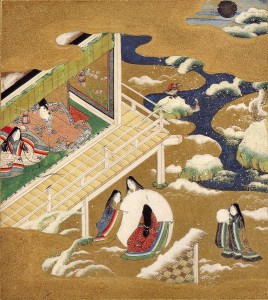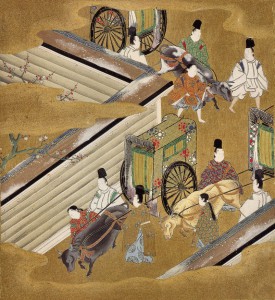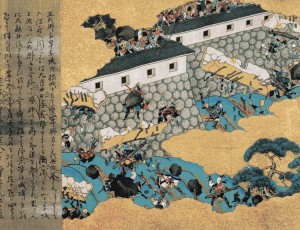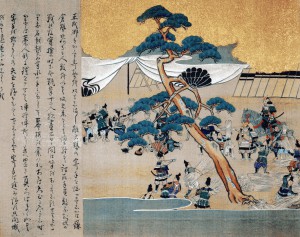Tosa School / Schools of Nihonga 006
Tosa School
Tosa School is a school that continued from the early Muromachi period to the end of the Edo period. In style it inherits the tradition of the *yamato-e painting and is characterized by unconstrained lines and bright colors. Its genealogy can be traced to Fujiwarano Yukimitsu (active c. 1352-89), but the name Tosa came to be used after Yukihiro (active c. 1406-51). In 1469, Mitsunobu (dates unknown) was given charge of the edokoro (official bureau of painting) and established a leading position among the art circle. However, with the death of Mitsumoto in battle in 1569, Tosa School declined for sometime. Yet, its artistic style was maintained by his disciple Mitsuyoshi. In 1634, Mitsuyoshi’s son Mitsunori (1583-1638) moved to Kyoto with his son Mitsuoki (1617-91) and worked for the revival of the school. In 1654, Mitsuoki regained the position at the edokoro and Tosa School continued until the end of the Edo period.
Tosa School was devoted to yamato-e, paintings specializing in subject matter and techniques derived from ancient Japanese art, as opposed to schools influenced by Chinese art, namely the Kanou School. Tosa School paintings are characterised by “areas of flat opaque color enclosed by simple outlines, where drawing is precise and conventional,” with many narrative subjects from Japanese literature and history. However by the 17th century both Tosa and Kanou artists broadened their range, and the distinction between these and other schools became less clear.
*Yamato-e painting:
In the latter half of the 9th century, during the Heian period, as court culture became more Japanized, paintings depicting scenery characteristic of Japan began to appear in response to the demand for paintings that express Japanese sentiments. From about the end of the 10 th century, this kind of painting, inheriting the style of the Heian period, began to be called yamato-e, to distinguish it from the Chinese painting/Chinese-style painting (later known as kanga), or paintings with Chinese themes that were influenced by Song and Yuan painting styles. The style of the yamafo-e painting was transmitted through edokoro (official bureau of painting) which had been in charge of court paintings since the Heian period. When the Tosa family inherited the administration of the edokoro (the courtly office for paintings) in the Muromachi period, the word yamato-e began to be used to refer not only to themes and style, but also to the concepts of the Tosa School.
Sumiyoshi School
Sumiyoshi School is one of the yamato-e painting groups that separated from Tosa School in the Edo period. Tosa Hiromichi (renamed Joukei in 1661), who studied under Tosa Mitsuyoshi and who was ordered by Emperor Gosai in 1662 to take the surname of Sumiyoshi, is the founder of Sumiyoshi School. The name is said to have its origin in the artist Keinin of the Kamakura period, a distant ancestor who lived in Sumiyoshi. While Tosa School was a group of yamato-e painting school active in Kyoto, Sumiyoshi School became a major school to transmit yamato-e painting in Edo and was also active as a group of official artists of the shogunate.

Kiyomizu-dera Engi Emaki (The Picture Scroll of the Origin of Kiyomizu-dera Temple) / Mitsunobu Tosa

Genji Monogatari (the Tale of Genji) Ch20: Asagao (The Morning Glory) / Mitsuoki Tosa

Genji Monogatari (the Tale of Genji) Ch42: Nioumiya (The Perfumed Prince) / Mitsuoki Tosa



